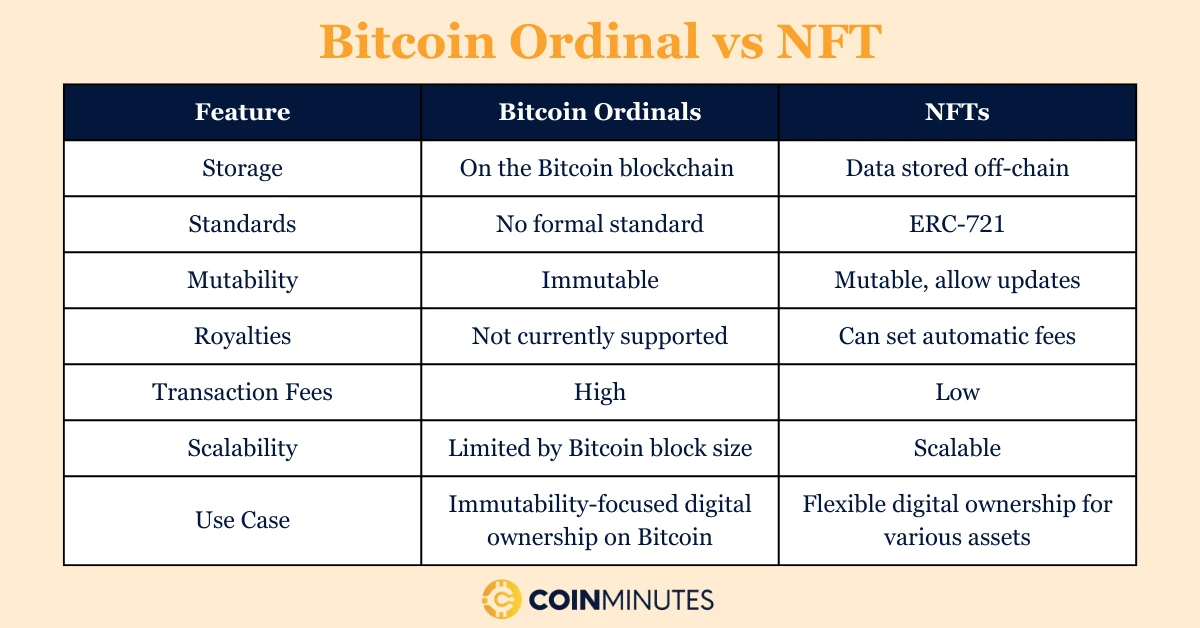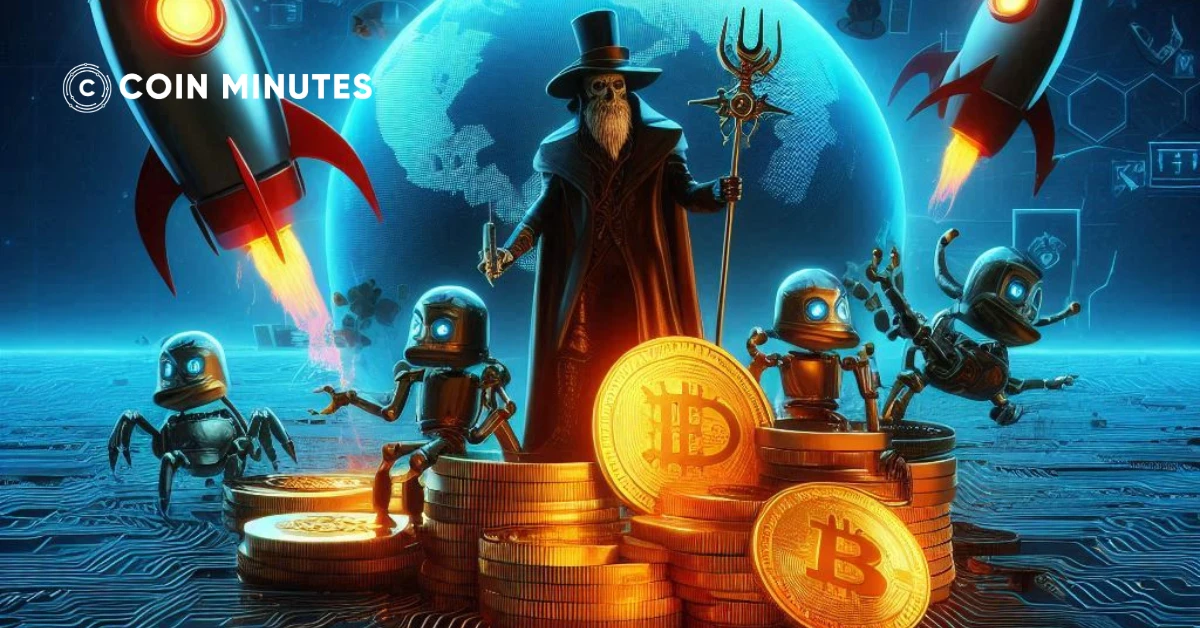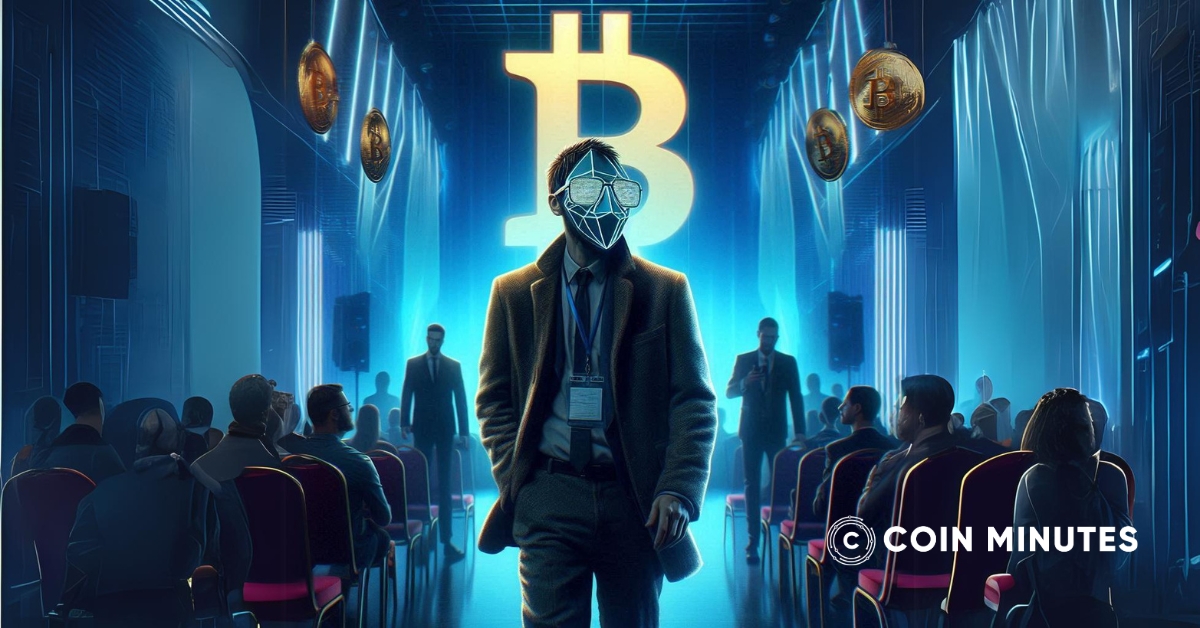A significant development in the Bitcoin ecosystem is the Bitcoin Ordinals protocol. This innovative protocol lets users create and own NFTs directly on the Bitcoin blockchain.
The emergence of Bitcoin Ordinals expands Bitcoin’s functionalities beyond just financial transactions, enabling it to store and manage various digital assets. By leveraging the robust security of the Bitcoin blockchain, Ordinals provide a potentially more secure way to store NFTs.
This article will dive deep into what they are, how they work, and the possibilities and potential drawbacks they present for the future of Bitcoin.
Key Takeaways
|
What Are Bitcoin Ordinals?
Bitcoin Ordinals are a new way to create non-fungible tokens (NFTs) on the blockchain directly. Bitcoin Ordinals function like a special NFT type on the blockchain instead of existing on a separate layer. Bitcoin Ordinal is a method for inscribing data (images, text, etc.) onto individual satoshis, the most minor units of Bitcoin. Since one Bitcoin equals 100 million satoshis, users can potentially create 100 million unique NFTs on a single Bitcoin.
How Do Bitcoin Ordinals Work?
Bitcoin Ordinals leverage a concept called “Ordinal Theory” to turn individual Satoshis (smallest unit of Bitcoin) into unique and potentially valuable digital assets. Here’s a breakdown of how they work:
- Ordinal Theory: This theory assigns a unique number (ordinal) to each Satoshi based on the order it was mined. The first mined Satoshi has the ordinal number 0, the second number 1, and so on. Every Satoshi in circulation has a specific ordinal assigned to it.
- Inscribing Data: Ordinal inscriptions involve attaching data like text, images, or even small videos directly onto a specific Satoshi using its ordinal number. This data becomes part of the Bitcoin transaction itself.
- Taproot Transactions: Ordinals rely on a Bitcoin feature called Taproot, which allows for more complex scripting within transactions. This scripting functionality enables the data embedding process for Ordinals.
- Transaction Size and Fees: Due to the data being stored directly on the blockchain, Ordinal transactions can be much larger than standard Bitcoin transactions. This translates to higher transaction fees for sending or receiving Ordinals.
- Immutability: Once inscribed, the data on an Ordinal becomes permanently embedded within the Bitcoin blockchain. This immutability is a core principle of Bitcoin and ensures the data’s permanence.
- Uniqueness and Value: Combining a unique ordinal number and inscribed data creates a one-of-a-kind Ordinal. The potential value of an Ordinal depends on various factors like the content itself, its rarity (ordinal number), and its creator.
Is Bitcoin Ordinal Good for Bitcoin?
Whether Bitcoin Ordinals are good for Bitcoin is a complex question with arguments on both sides. Here’s a breakdown of the potential benefits and drawbacks.
Pros
- Increased Demand for Block Space: Ordinals require more data storage on the blockchain, which could incentivize miners and increase transaction fees in the long run. This might benefit Bitcoin’s security as transaction fees become the primary source of miner revenue after block rewards eventually disappear.
- Expanded Functionality: Ordinals introduce a new layer of functionality to Bitcoin, potentially attracting a broader user base interested in digital collectibles and NFTs on the Bitcoin network.
- Leveraging Security: By storing data directly on the Bitcoin blockchain, Ordinals benefit from Bitcoin’s robust security features, potentially making them more secure than some off-chain NFT solutions.
Cons
- Scalability Issues: Large Ordinals can congest the Bitcoin network, leading to slower transaction times and higher fees for regular transactions. This could affect Bitcoin’s usability as a currency.
- Network Strain: Ordinals’ increased data storage requirements could strain the Bitcoin network’s capacity in the long run, potentially hindering its ability to scale effectively.
- Centralization Risks: The emergence of Ordinal-specific marketplaces and wallets might create centralized control points within the ecosystem, potentially contradicting Bitcoin’s decentralized philosophy.
Bitcoin Ordinals represent a significant innovation, but their overall impact on Bitcoin remains to be seen. While they offer exciting possibilities for NFT creation, security, and ecosystem expansion, potential drawbacks like block space congestion and philosophical debates can’t be ignored.
The future of Bitcoin Ordinals will depend on how the community addresses these challenges. Can Ordinals be integrated seamlessly without compromising Bitcoin’s core functionality? Can user-friendly interfaces make them more accessible? These questions will determine whether Bitcoin Ordinals become a boon or a bane for the future of Bitcoin.
Bitcoin Ordinals vs NFTs
Both Bitcoin Ordinals and NFTs represent digital ownership of unique items, but they differ in some key aspects:

The choice depends on your needs. If immutability and leveraging the Bitcoin blockchain are paramount, Ordinals might be an option. However, for most users, traditional NFTs’ flexibility and broader adoption make them a more practical choice.
How to Get Bitcoin Ordinals?
Here’s a guide on how to obtain Bitcoin Ordinals (whether by buying or creating them):
Purchasing Bitcoin Ordinals on a Marketplace
- Choose a Marketplace: Select a reputable Bitcoin Ordinals marketplace like Ordinals Wallet or OKX.
- Set Up a Wallet: Create an account on the chosen marketplace and connect your Taproot-enabled Bitcoin wallet. Ensure your wallet has sufficient Bitcoin for transactions.
- Browse and Select: Explore the marketplace’s Ordinal collections and pick your desired one.
- Initiate Purchase: Choose the specific Ordinal you want and proceed with the buying process. Confirm the transaction details and pay the required Bitcoin amount.
- Receive Your Ordinal: Once the transaction is successful, your Bitcoin Ordinal will be transferred to your connected wallet. You can manage and view your Ordinals from within the marketplace or your wallet.
Creating Your Own Bitcoin Ordinals
- Obtain a Taproot Wallet: Install a Taproot-enabled Bitcoin wallet like Hiro Wallet or Xverse. These wallets allow Ordinal inscription and management.
- Inscription Tools: Acquire tools for creating inscriptions. Options include Bitcoin Core or third-party inscription tools like the Inscribe. app.
- Prepare the Inscription: Choose the data you want to inscribe onto an Ordinal (text, images, etc.). Use the inscription tool to prepare the inscription data.
- Connect Your Wallet: Connect your Taproot wallet to the inscription tool.
- Initiate Inscription: Begin the inscription process by following the tool’s instructions. This involves creating a Bitcoin transaction that embeds your chosen data.
- Pay Transaction Fees: Pay the required Bitcoin transaction fees to finalize the inscription.
- Verify Inscription: Once the transaction is confirmed, your Bitcoin Ordinal will be created and stored in your connected wallet.
The Bottom Line
Bitcoin Ordinals represent a groundbreaking expansion of Bitcoin’s capabilities, allowing for the direct creation and ownership of NFTs on the Bitcoin blockchain.
While they offer enhanced security and new functionality, they also pose potential challenges such as increased transaction fees and scalability issues.
The future impact of Bitcoin Ordinals will largely depend on how the community addresses these challenges and integrates this innovation without compromising Bitcoin’s core features.






